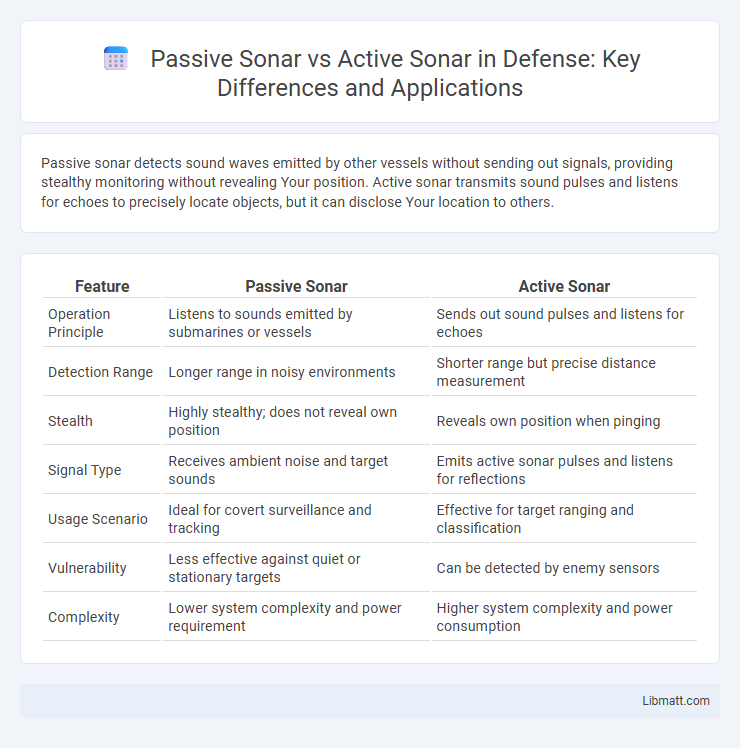Passive sonar detects sound waves emitted by other vessels without sending out signals, providing stealthy monitoring without revealing Your position. Active sonar transmits sound pulses and listens for echoes to precisely locate objects, but it can disclose Your location to others.
Table of Comparison
| Feature | Passive Sonar | Active Sonar |
|---|---|---|
| Operation Principle | Listens to sounds emitted by submarines or vessels | Sends out sound pulses and listens for echoes |
| Detection Range | Longer range in noisy environments | Shorter range but precise distance measurement |
| Stealth | Highly stealthy; does not reveal own position | Reveals own position when pinging |
| Signal Type | Receives ambient noise and target sounds | Emits active sonar pulses and listens for reflections |
| Usage Scenario | Ideal for covert surveillance and tracking | Effective for target ranging and classification |
| Vulnerability | Less effective against quiet or stationary targets | Can be detected by enemy sensors |
| Complexity | Lower system complexity and power requirement | Higher system complexity and power consumption |
Introduction to Passive and Active Sonar
Passive sonar uses hydrophones to detect sound waves emitted by vessels or marine life without transmitting any signals, providing stealth and energy efficiency. Active sonar emits sound pulses and listens for echoes to determine the distance and direction of objects, offering precise targeting but increasing the risk of detection. Both systems play crucial roles in underwater navigation, surveillance, and defense applications.
Fundamental Principles of Sonar Technology
Passive sonar relies on detecting sound waves emitted by other objects, enabling stealthy underwater monitoring without revealing your position. Active sonar emits sound pulses and listens for echoes, providing precise location data of targets but potentially exposing your presence. Understanding these fundamental principles allows effective deployment of sonar technology based on mission requirements and environmental conditions.
How Passive Sonar Works
Passive sonar detects underwater sounds by listening to acoustic signals emitted by vessels or marine life without transmitting any noise itself. It uses hydrophones to capture sound waves, then processes these signals to determine the direction and distance of the source quietly and without revealing its own position. This stealthy detection method is critical for naval operations and marine monitoring where avoiding detection is essential.
How Active Sonar Works
Active sonar emits sound pulses into the water and measures the time it takes for the echoes to return after bouncing off objects, enabling precise location and distance detection. This method provides real-time tracking of submarines, ships, and underwater terrain by analyzing the characteristics of the reflected sound waves. The amplitude, frequency, and timing of echoes allow for accurate identification and classification of targets in complex underwater environments.
Key Differences Between Passive and Active Sonar
Passive sonar detects underwater sounds emitted by vessels or marine life without sending out signals, relying on hydrophones to capture acoustic energy. Active sonar emits sound pulses and listens for echoes to determine the location, distance, and speed of objects, providing precise real-time data. Your choice between passive and active sonar depends on operational needs for stealth versus detailed detection capabilities.
Applications of Passive Sonar
Passive sonar is primarily used for stealth detection and monitoring of underwater vessels, making it essential in naval operations and submarine warfare. It is effective in tracking enemy submarines, underwater vehicles, and marine life without revealing your position, relying on the sounds emitted by these targets. Civilian applications include maritime traffic monitoring, underwater environmental studies, and search-and-rescue missions.
Applications of Active Sonar
Active sonar is widely used in naval warfare and maritime navigation for detecting and tracking submarines, underwater mines, and other vessels by emitting sound pulses and analyzing their echoes. Its applications extend to commercial shipping for collision avoidance and in underwater research to map seafloor topography or monitor marine life behavior. You benefit from its capability to provide precise location data even in complex underwater environments where passive sonar may be less effective.
Advantages and Limitations of Passive Sonar
Passive sonar offers the critical advantage of stealth by detecting sounds emitted by vessels without revealing the listener's position, making it ideal for covert naval operations. It excels in long-range detection and energy efficiency, as it does not emit signals that could be intercepted by adversaries. However, passive sonar's limitations include an inability to determine target distance or precise location and reduced effectiveness in noisy environments where ambient sounds can mask target signatures.
Advantages and Limitations of Active Sonar
Active sonar provides precise target detection and range estimation by emitting sound pulses and analyzing their echoes, enabling effective tracking in various underwater environments. Its main advantage is the ability to detect objects with high accuracy, even in cluttered or noisy waters, but this comes at the risk of revealing the emitter's location to adversaries. Limitations include increased energy consumption, potential interference with marine life, and susceptibility to countermeasures such as sonar jamming or deception tactics.
Choosing the Right Sonar System: Factors to Consider
Choosing the right sonar system involves evaluating mission objectives, detection range, and environmental conditions. Passive sonar excels in stealth and long-duration monitoring by detecting sound waves emitted from objects, while active sonar provides precise target location through emitted pulses but can reveal the user's position. Key factors include operational stealth requirements, target type, acoustic environment, and power availability to optimize sonar system effectiveness.
passive sonar vs active sonar Infographic

 libmatt.com
libmatt.com